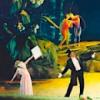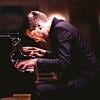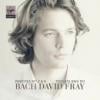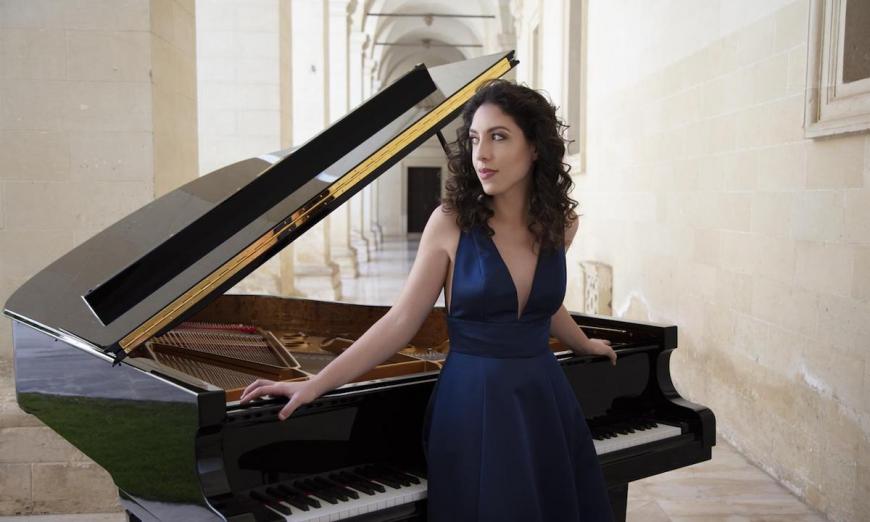
Taking the classical world by storm, Italian pianist Beatrice Rana has been a force on the music scene since winning the prestigious Montreal International Musical Competition in 2011. Two years later, Rana snagged a Silver Medal and the Audience Award at the Van Cliburn International Piano Competition — when she was a mere 20 years old.
Growing up in a small town in Puglia, where both her parents were professional pianists, the musician earned a degree in piano under the guidance of Benedetto Lupo at the Nino Rota Conservatory in Monopoli before studying with Arie Vardi at the Hochschule für Musik in Hanover. Since then, Rana has electrified audiences at the world’s most celebrated concert halls and festivals, among them London’s Wigmore Hall, Paris’s Théâtre des Champs-Elysées, and Walt Disney Concert Hall. Of her solo recital debut at Carnegie Hall, The New York Times’ Anthony Tommasini wrote that Rana’s rendition of Chopin’s Op. 25 Études, “made the pieces sound as poetic and colorful as anything Chopin ever wrote.”
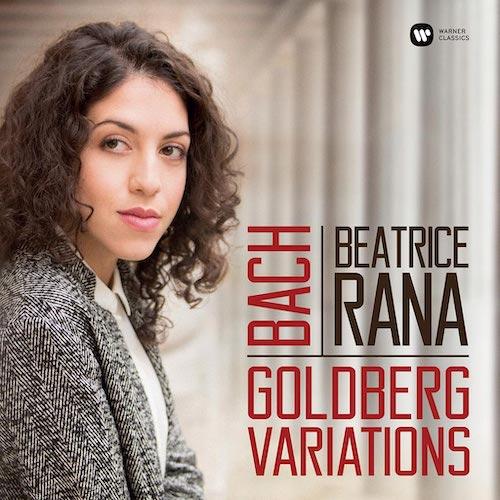
Rana’s discography is also impressive. She released her first album in 2015, featuring Prokofiev’s Piano Concerto No. 2 and Tchaikovsky’s Piano Concerto No. 1 with Antonio Pappano and Orchestra dell’Accademia Nazionale di Santa Cecilia, and her 2017 recording of Bach’s Goldberg Variations was deemed a feat for someone so young. Winning Gramophone magazine’s award for Young Artist of the Year in 2017, Rana followed that milestone by being nominated as Female Artist of the Year at the Classic BRIT Awards, where the pianist performed for a nationally televised broadcast at Royal Albert Hall. And in September of this year, Rana will be releasing her seventh album, this one dedicated to Chopin.
Because of the pandemic, however, the pianist’s fiendishly busy schedule ground to a halt. But she recently filmed a concert for Cal Performances, which premieres May 13 and will be available on demand through June 12. I spoke with the pianist by phone from her home in Rome, where, in her charmingly accented English, we covered topics that included life during COVID-19, the notion that her life as a pianist was not necessarily predestined, and her upcoming filmed recital.
First of all, how have you been faring during the pandemic and what was it like performing a concert in Madrid with violinist Renaud Capuçon in March before a live audience? Were you both wearing masks?
Life for us during this time has been extremely difficult and challenging, but to perform in Madrid for a real audience, it was an island of happiness in this period. In Madrid there was a 50 percent audience. It was very cleverly thought out — people that were living together could sit together and there could be more distance with people not related to each other.
We were not wearing masks and we were distanced. For me, it was challenging, because I renounced to have a page turner so I could play without a mask. A page turner would have to sit next to me so I decided to turn the pages myself.
Literally, or did you use an iPad?
I don’t use an iPad, because what I am always scared of is it crashing. I use it to practice, but not in concert.
Since your parents are both professional musicians, was it a given that you would become a professional pianist, as well?
Not at all. Of course, I grew up with a lot of music — and I think I was lucky because being professionals, they knew how difficult it would be to become professional. They never forced me to do anything. They just wanted me to learn music to be a better person. They urged a positive approach to music. When I eventually decided I wanted to become a pianist, they were very happy. But I think they would have been happy with any job I would have chosen.
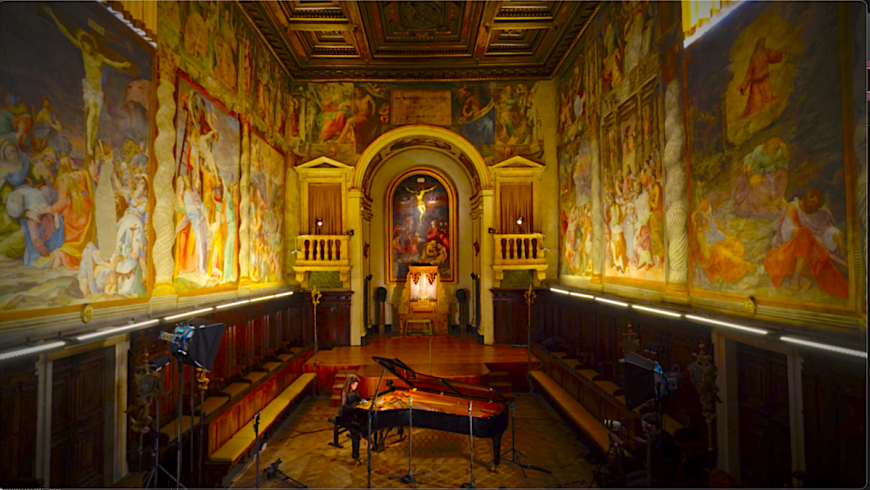
Let’s talk about your concert for Cal Performances. Why did you choose to film at Rome’s Oratorio del Gonfalone, a 16th-century Renaissance church, and how did you decide on a program featuring Bach, Chopin’s four, shall we say, diabolical and expressive scherzos, and the first book of Debussy’s demanding Études?
The church is a wonderful place in an historical center. It’s like a small Sistine chapel. There are old paintings and frescos all over the place. When Cal Performances asked me to play a streamed recital, it immediately came to my mind. Because the lack of an audience is very big for an artist, I had to take energy from something else — a piece of art or an artistic place. We filmed it there and it was especially wonderful playing in such a venue.
[Regarding the repertory] it’s a program with a French connection. I start by playing the Bach French Suite, No. 2, then a selection of Études by Debussy and it finishes with Chopin’s Four Scherzos, two of which were written in Paris. So it’s not only French composers, but all these composers were inspired by France [and] it’s very diverse. The Bach suites are absolutely beautiful, so lyrical and so refined, in a way. The Debussy Études are one of the last pieces he wrote, with a lot of humor and [they’re] also very abstract for his style.
The Chopin [works] are a journey through his life. The first was written when he was very young and he had just left Poland and then it finishes with the fourth which belongs to the last period of his life. They are difficult with a lot of contrasts, especially the first three scherzos [which] are extremely dramatic. It’s a complete work and they have a very powerful force.
I understand that the Debussy is new to your repertory?
Yes, Debussy is the first time for me. It’s a program that is a production of this pandemic, because what I had planned to play for these recitals — and generally speaking for 2021 — when I decided the programs for this year it was 2019, before everything happened. Then came the pandemic and I found myself at home doing nothing. I started questioning myself, what I wanted to do and not what I had to do. The pieces like Bach and Debussy came to my mind. It was not planned for me. In a way, these are the small advantages of a period like the pandemic.
You made your Carnegie Hall debut just two years ago. What was that like and do you read your reviews — which are basically raves like Gramophone magazine’s coverage of your Goldberg Variations disc, where the reviewer declared that Beatrice Rana “possesses an old soul that belies her twenty years, and more than a touch of genius.”
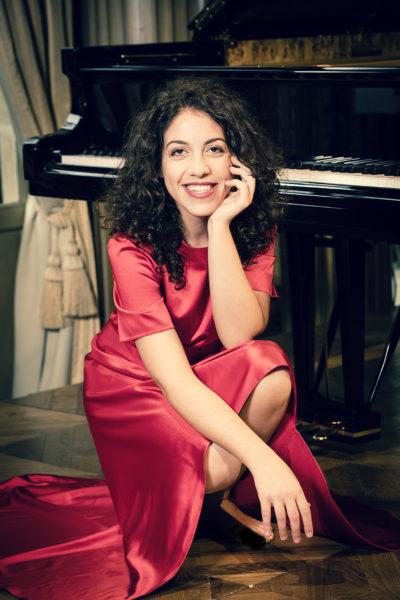
For me — for every artist — to get to the stage of Carnegie Hall is incredible. I can remember those days with a mix of excitement and responsibility and expectations and how it was everything to play on such a stage that is the biggest joy. I usually don’t read reviews, because it’s always a bit strange and sometimes painful and sometimes flattering. I want to avoid that because I just don’t want to have these extremes and also I don’t want the review to influence myself. Of course, I try to learn from every performance onstage, but I prefer that be an inner process rather than something coming from outside.
And speaking of repertory, what is it about Beethoven’s “Appassionata” Sonata that keeps you from playing it in public these days?
I played many times the “Appassionata,” [but] it was a love/hate relationship. It’s a piece I adore but I was never satisfied with the result, so I decided I would never play it any more in front of an audience. It was more than 10 years ago — I was a teenager — but I worked this piece like crazy. I hope that I will change ideas at some point, when things are so personal that [I] don’t have to fight it — but I don’t feel ready to go back to this piece. You have to be convinced when you bring pieces on stage and I never felt 100 percent confident with this.
You’re quite active on social media, and have some 18,000 followers on Instagram, where your bio reads, “Pianist by night, globetrotter by day. Full Time dreamer.” What are your current dreams and where do you see yourself in the next five to 10 years?
Two years ago, I would have replied very easily to this question, but now that everything turned into such a mess, to answer this question is very difficult. I just hope that in five years we will find again the wellness, this feeling to trust the other and to stay well with the other. We question everything now. We question the others, the safety to go listen to the concerts. In five years, I hope we stop questioning everything and can live our life with more spontaneity.
Personally, I hope that in five years I will be able to share music as I used to do — with many people in a lot of countries and cultures, but at the same time with a private life. I discovered the pleasure of spending so much time with family and friends and I don’t want to lose what I actually gained in this year. I hope that I will find a balance.
We certainly have been in a moment, so what is it that we can expect art to do during these uncertain times and does the artist have a responsibility to do it?
I think that artists are people, human beings, and at this moment, every human being has a huge responsibility. It was very difficult to understand at first because we were experiencing something we never expected. As artists, we are public figures and have more responsibility — what I feel that there is a common awareness, that we need to have this responsibility.
In a way, COVID made social distancing even more evident than before. In our society there were already a lot of differences between human beings. There are certain cultural distances [including a lack of] equality. I hope that this social distancing will not destroy what we were trying to build. We as artists and as every human being, we have to find this. The distance has to be only physical, not social. We have to fight very hard to get this.


